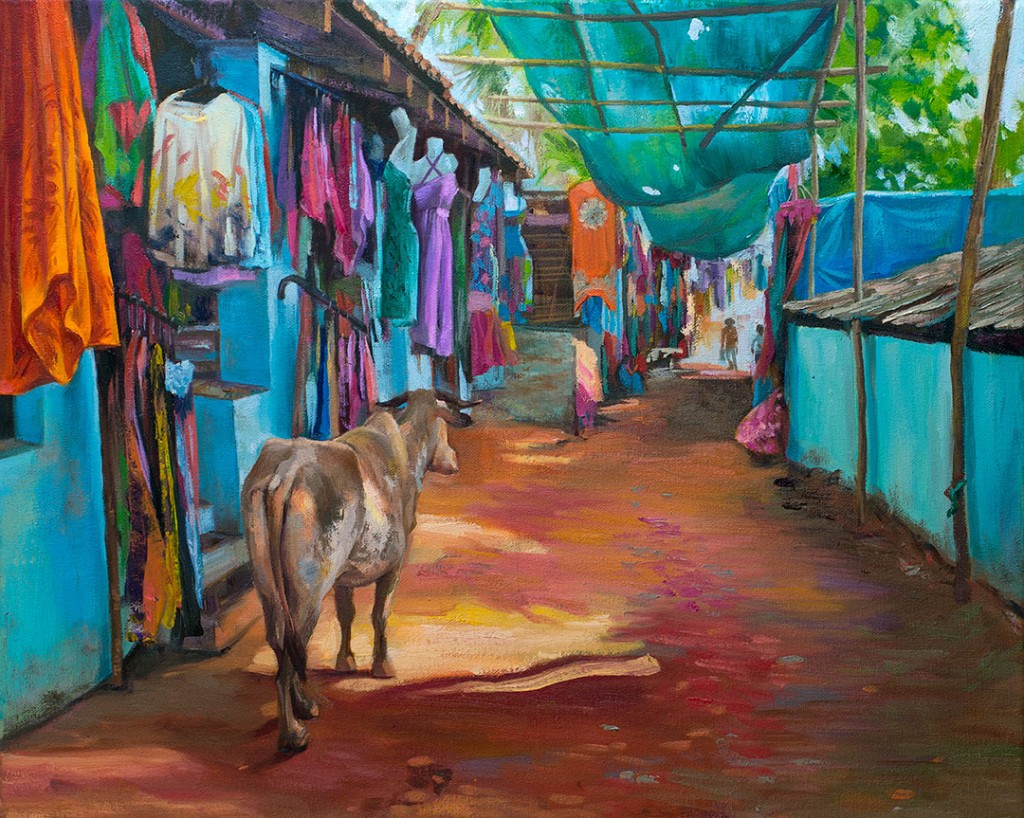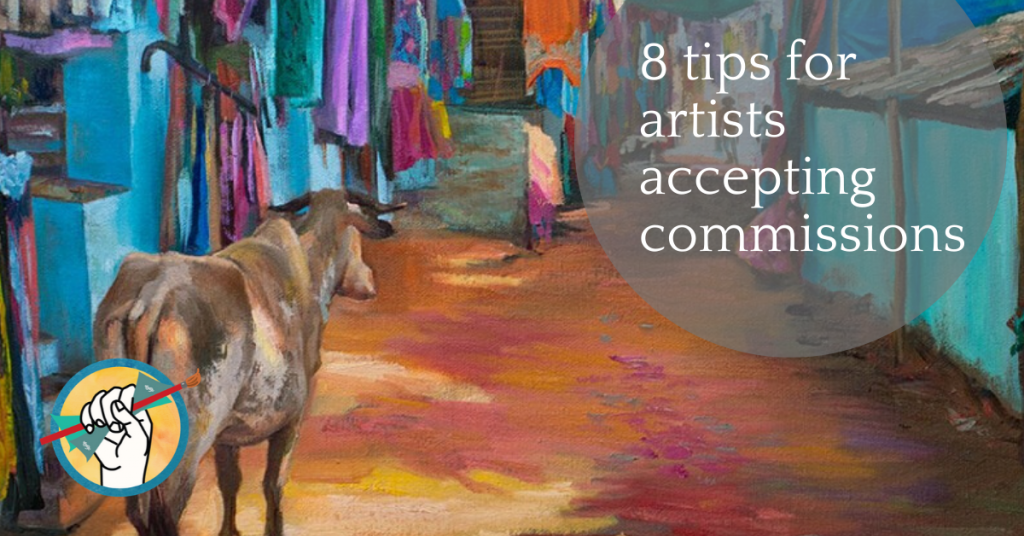If I Commissioned Art Can I Duplicate It and Sell It

As a cocky-employed artist, I rely on commissions more so than selling my piece of work in galleries. However, some artists are not bully negotiators or business-minded, and art commissions that start off optimistic can sometimes turn into a sour feel. These eight tips will help yous maintain good clients, manage their expectations, and produce work with integrity.

one – Timing is primal. Be responsive and follow up on your leads immediately.
If someone expresses involvement in buying one of your pieces, but can't make a deposit or payment right away, have downwards their contact info and follow up with them by the end of the twenty-four hour period/outcome. Most people who buy art don't "need" information technology. It's a luxury item that is frequently an impulse purchase — they fall in dear with the art and have to accept information technology. But if you lot expect too long, the infatuation tin fade or even transfer to another detail. If the art is intended equally a gift, timing is even more important. I learned while working in advertisement that no matter how well your product is advertised, if you don't make the sale at the correct time, you've missed the take chances. Merely luckily, people are more than willing to wait when it comes to fine art.
two – Don't be shy to state your terms.
It'southward always wise to take an artist's agreement signed past both parties to protect you from unwarranted situations. Starting time off, licensing terms should exist made clear. Does the customer want the right to reproduce the artwork for commercial use/sale? They may recollect that owning the artwork is the aforementioned as owning the license to reproduce it equally they see fit. It's your chore to educate them if this is the case. Nigh artists retain their licensing rights for their work even after a auction. Merely an unaware customer may accept your committee and innocently reproduce it on T-shirts or publish it for commercial employ without informing you first. That will definitely pb to a sticky state of affairs that could be avoided. Freelance artists may also ask for a "impale fee" — a mandatory fee in case the project is cancelled midway. Kill fees can exist 50 – 100% of the project cost, depending on how soon the project is cancelled.
3 – Inquire for a payment upwardly front.
It's fair to ask for equally much equally 50% upward forepart to cover the cost of your materials and fourth dimension. Some people prefer xxx% down and a couple of installments. I would recommend taking between xxx – 50% upwards forepart, unless the commission is for a friend or somebody who has good standing credit with y'all. For larger commissions, consider a monthly payment plan, where y'all ship your client monthly progress updates. Making a payment will aid both the patron and the creative person stay invested in the piece, and build a credible professional relationship.
4 – Know exactly what you're being asked to do.
Be articulate in your descriptions and check in with the client at certain intervals. Call back why the client chose you lot to begin with, and don't doubt your ability. Do accept creative license — this is why you were hired! DO start with concepts or sketches for them to approve before moving on to plush or big scale piece of work. DON'T check in besides often, or seem unsure of yourself or ideas, every bit this is an open up invitation for your patron to suggest their ideas, or peradventure drag y'all along a creative journey that isn't your own. They're just trying to aid, but information technology's probably doing the contrary.
5 – Cherish your good clients, and learn to manage difficult ones.
Non every commission volition go smoothly, but don't let a few bad experiences ruin the potential for bang-up ones. I've had my share of difficult clients, especially when I was an eager and fresh art school graduate. This is a learning curve that will accept experience, but here are some cues to watch out for. The skillful clients will insist on paying you upward front end, leave a lot of the artistic license to you, and give you a wide spectrum to work with without interfering with your creative process. Hang on to the good clients, equally their trust will inspire you to exist more than artistic, resulting in more portfolio pieces, and you'll love what you practice even more. The bad ones will try to dictate how y'all do things, change their minds after y'all've already started, or micromanage your work — just they insist they're simply trying to help. Good client direction skills and educating your client on your process — like what you Exercise and DON'T need from them in terms of creative input — is crucial to keeping the integrity in your work.
6 – Know your market.
What blazon of art do you enjoy creating the near? What type of fine art are you all-time at? If you market yourself wisely, you'll cease upward with commissions you absolutely enjoy. I had trouble deciding for a long time because I savor creating in many styles — my piece of work ranges from plein air landscapes and travel memoirs to quirky nighttime illustrations to colourful portraits. If I had to choose, I practice bask the illustrations the about, simply they take the most fourth dimension and take a much slimmer market compared to the landscapes and colourful portraits.
seven – Take a method to pricing your work.
This will preclude panic when an opportunity comes up. Most artists price their work based on a per project rate ($ = estimated hours to completion 10 hourly rate) or based on size ($/sq footage) merely there are four variables to keep in mind:
one) Time – Will y'all exist working weekends or long hours? Or can you do this leisurely in a couple of hours? Is it due immediately, or tin you have your time?
2) Size – Larger pieces crave more paint, materials, handling, shipping costs, etc.
3) Skill Required – Portraits and figurative fine art generally require more than skill than landscapes, so they are priced higher. Is the subject complex, like lace or patterning that requires a lot of detail?
4) Artistic Integrity – Will this piece enhance your portfolio, or volition you never show information technology off afterwards it'south consummate? Is the project interesting, meaningful, and fun to work on?
8 – Provide a good feel by sharing your process.
The more open and honest you stay with a client, the more than positive the experience will be for both parties. Check in periodically, and ship them some photos of piece of work in progress, or an enthusiastic update. I can't stress the enthusiasm enough: You lot are the creative person. If you sound excited about your piece, so will the client. If you sound unsure or unconfident, chances are your customer volition too lose confidence in the project.
Markham creative person Stacey MacNevin stresses the importance of not just delivering a painting, but delivering an overall experience. She advises, "Spend the time up front really listening to what a client wants for their piece. They may say: 'I love your stuff — practice whatever you desire' but what they are really asking y'all for is an experience." Commissioning an artist should be an interesting, thrilling, and enjoyable experience that is rich in chat and inventiveness. And so take the fourth dimension to understand your customer, mind to their vision, and give them some insight into your creative process. It'south worth the time ii-fold: the client will feel more connected to the piece considering they are now more continued to your process.
While art commissions tin sometimes exist an practise in trial and error, in my feel, these tips make clients happy and allow you to maintain your artistic integrity and artistic vision.
Virtually THE ARTIST
 Fei Lu is a cocky-employed artist, artistic director, and founder of Winged Canvas Art Hub in Markham, Ontario. Her paintings are known to be colourful and provocative with a impact of sense of humor, hinting at a deeper story backside each painting. Her artwork has been published in Applied Arts and American Illustration and in individual collections worldwide.
Fei Lu is a cocky-employed artist, artistic director, and founder of Winged Canvas Art Hub in Markham, Ontario. Her paintings are known to be colourful and provocative with a impact of sense of humor, hinting at a deeper story backside each painting. Her artwork has been published in Applied Arts and American Illustration and in individual collections worldwide.
Source: https://theabundantartist.com/8-tips-artists-accepting-commissions/
Enregistrer un commentaire for "If I Commissioned Art Can I Duplicate It and Sell It"